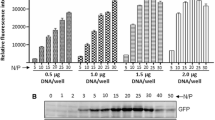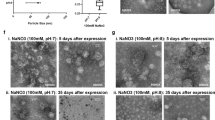ABSTRACT
Purpose
Murine leukemia virus-like particles (M-VLP) complexed with polymers to promote cellular uptake and endosomal escape represent a new class of effective gene delivery vectors. Building upon recent studies of viral-synthetic hybrid vectors, we report the effects of serum on the formation, activity and stability of PEI/M-VLP complexes.
Methods
M-VLP were produced by cells grown in serum-supplemented media (M-VLP-S), serum-free media (M-VLP-SF) or serum-free Opti-MEM® I (M-VLP-OM). PEI/M-VLP stoichiometry was varied to investigate complex formation and optimal transfection conditions. The effects of prolonged storage, freeze-thaw cycles, and ultracentrifugation of M-VLP on the stability of vector transduction efficiency were also observed.
Results
M-VLP-S required more PEI to form infective complexes than M-VLP-SF and M-VLP-OM. The stoichiometry of PEI/M-VLP-S was dependent on total PEI concentration (7–8 μg/100 μL M-VLP supernatant), while optimal infectivity of PEI/M-VLP-SF and PEI/M-VLP-OM depended on PEI/M-VLP ratios (12–17 μg and 10–14 μg PEI/109 M-VLP, respectively). PEI/M-VLP-SF and PEI/M-VLP-OM complexes were significantly more efficient than PEI/M-VLP-S. Stability of the hybrid vectors was not significantly affected by serum.
Conclusions
PEI/M-VLP complexes exhibiting increased efficiency were constructed by producing M-VLP in serum-free media. M-VLP could be stored by freezing or refrigeration and concentrated by ultracentrifugation without unacceptable loss of infectivity.





Similar content being viewed by others
REFERENCES
Blaese RM, Culver KW, Miller AD, Carter CS, Fleisher T, Clerici M, et al. T lymphocyte-directed gene therapy for ADA- SCID: initial trial results after 4 years. Science. 1995;270:475–80.
Cavazzana-Calvo M, Hacein-Bey S, de Saint Basile G, Gross F, Yvon E, Nusbaum P, et al. Gene therapy of human severe combined immunodeficiency (SCID)-X1 disease. Science. 2000;288:669–72.
Cavazzana-Calvo M, Hacein-Bey S, Yates F, de Villartay JP, Le Deist F, Fischer A. Gene therapy of severe combined immunodeficiencies. J Gene Med. 2001;3:201–6.
Bainbridge JWB, Smith AJ, Barker SS, Robbie S, Henderson R, Balaggan K, et al. Effect of gene therapy on visual function in Leber’s congenital amaurosis. N Eng J Med. 2008;358:2231–9.
Levine BL, Humeau LM, Boyer J, MacGregor RR, Rebello T, Lu X, et al. Gene transfer in humans using a condionally replicating lentiviral vector. Proc Natl Acad Sci USA. 2006;103:17372–7.
Pulkkanen KJ, Yla-Herttuala S. Gene therapy for malignant glioma: current clinical status. Molec Ther. 2005;12:585–98.
Rein DT, Breidenbach M, Curiel DT. Current developments in adenovirus-based cancer gene therapy. Future Oncol. 2006;2:137–43.
Morgan RA, Dudley ME, Wunderlich JR, Hughes MS, Yang JC, Sherry RM, et al. Cancer regression in patients after transfer of genetically engineered lymphocytes. Science. 2006;314:126–9.
Hollon T. Researchers and regulators reflect on first gene therapy death. Nat Med. 2000;6:6.
Kaiser J. Gene therapy. Panel urges limits on X-SCID trials. Science. 2005;307:1544–5.
Pack DW, Hoffman AS, Pun S, Stayton PS. Design and development of polymers for gene delivery. Nat Rev Drug Disc. 2005;4:581–93.
Alton EW, Stern M, Farley R, Jaffe A, Chadwick SL, Phillips J, et al. Cationic lipid-mediated CFTR gene transfer to the lungs and nose of patients with cystic fibrosis: a double-blind placebo-controlled trial. Lancet. 1999;353:947–54.
Madhusudan S, Tamir A, Bates N, Flanagan E, Gore ME, Barton DPJ, et al. A multicenter phase I gene therapy clinical trial involving intraperitoneal administration of E1A-lipid complex in patients with recurrent epithelial ovarian cancer overexpressing HER-2/neu oncogene. Clin Cancer Res. 2004;10:2986–96.
Bremner KH, Seymour LW, Pouton CW. Harnessing nuclear localization pathways for transgene delivery. Curr Opin Mol Ther. 2001;3:170–7.
Yoo HS, Jeong SY. Nuclear targeting of non-viral gene carriers using psoralen-nuclear localization signal (NLS) conjugates. Eur J Pharm Biopharm. 2007;66:28–33.
Moore NM, Sheppard CL, Sakiyama-Elbert SE. Characterization of a multifunctional PEG-based gene delivery system containing nuclear localization signals and endosomal escape peptides. Acta Biomater. 2009;5:854–64.
Lee H, Jeong JH, Park TG. A new gene delivery formulation of polyethylenimine/DNA complexes coated with PEG conjugated fusogenic peptide. J Controlled Rel. 2001;76:183–92.
Lee GK, Maheshri N, Kaspar B, Schaffer DV. PEG conjugation moderately protects adeno-associated viral vectors against antibody neutralization. Biotechnol Bioeng. 2005;92:24–34.
Carlisle RC, Benjamin R, Briggs SS, Sumner-Jones S, McIntosh J, Gill D, et al. Coating of adeno-associated virus with reactive polymers can ablate virus tropsim, enable retargeting and provide resistance to neutralising antisera. J Gene Med. 2008;10:400–11.
Kreppel F, Kochanek S. Modification of adenovirus gene transfer vectors with synthetic polymers: a scientific review and technical guide. Mol Ther. 2008;16:16–29.
Croyle M, Callahan S, Auricchio A, Schumer G, Linse K, Wilson J. PEGylation of a vesicular stomatitis virus G pseudotyped lentivirus vector prevents inactivation in serum. J Virol. 2004;78:912–21.
Croyle MA, Yu QC, Wilson JM. Development of a rapid method for the PEGylation of adenoviruses with enhanced transduction and improved stability under harsh storage conditions. Hum Gene Ther. 2000;11:1713–22.
Kim P, Kim T, Yockman J, Kim S, Yun C. The effect of surface modification of adenovirus with an arginine-grafted bioreducible polymer on transduction efficiency and immunogenicity in cancer gene therapy. Biomaterials. 2010;31:1865–74.
Ramsey J. Hybrid gene therapy vectors comprised of synthetic polymer and noninfectious virus-like particles. PhD Dissertation. 2006.
Ramsey JD, Vu HN, Pack DW. Top down approach for construction of hybrid polymer-virus gene delivery vectors. J Controlled Rel. 2010;144:39–45.
Forrest ML, Koerber JT, Pack DW. A degradable polyethylenimine derivative with low toxicity for highly efficient gene delivery. Bioconjug Chem. 2003;14:934–40.
Drake DM, Pack DW. Biochemical investigation of active intracellular transport of polymeric gene-delivery vectors. J Pharm Sci. 2008;97:1399–413.
Vu HN, Ramsey JD, Pack DW. Engineering of a stable retroviral gene delivery vector by directed evolution. Molec Ther. 2008;16:308–14.
Merten OW. State-of-the-art of the production of retroviral vectors. J Gene Med. 2004;6:S105–24.
Andreadis ST, Brott D, Fuller AO, Palsson BO. Moloney murine leukemia virus-derived retroviral vectors decay intracellularly with a half-life in the range of 5.5 to 7.5 hours. J Virol. 1997;71:7541–8.
Le Doux JM, Davis HE, Morgan JR, Yarmush ML. Kinetics of retrovirus production and decay. Biotechnol Bioeng. 1999;63:654–62.
Higashikawa F, Chang L. Kinetic analyses of stability of simple and complex retroviral vectors. Virology. 2001;280:124–31.
Andreadis ST, Palsson BO. Kinetics of retrovirus mediated gene transfer: the importance of intracellular half-life of retroviruses. J Theor Biol. 1996;182:1–20.
ACKNOWLEDGMENTS
This work was supported by the National Science Foundation (BES 06-02636) and the American Cancer Society (RSG-05-019-01-CDD). Flow cytometry was performed at the Flow Cytometry Facility of the Roy J. Carver Biotechnology Center at the University of Illinois, and confocal microscopy was performed at the Center for Microscopic Imaging at the University of Illinois College of Veterinary Medicine.
Author information
Authors and Affiliations
Corresponding author
Electronic supplementary materials
Below is the link to the electronic supplementary material.
Supplementary Fig. 1
(DOC 207 kb)
Rights and permissions
About this article
Cite this article
Drake, D.M., Keswani, R.K. & Pack, D.W. Effect of Serum on Transfection by Polyethylenimine/Virus-Like Particle Hybrid Gene Delivery Vectors. Pharm Res 27, 2457–2465 (2010). https://doi.org/10.1007/s11095-010-0238-z
Received:
Accepted:
Published:
Issue Date:
DOI: https://doi.org/10.1007/s11095-010-0238-z




